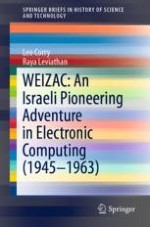2019 | OriginalPaper | Chapter
3. The WEIZAC Challenge: Building an Electronic Brain in Rehovot
Authors : Leo Corry, Raya Leviathan
Published in: WEIZAC: An Israeli Pioneering Adventure in Electronic Computing (1945–1963)
Publisher: Springer International Publishing
Activate our intelligent search to find suitable subject content or patents.
Select sections of text to find matching patents with Artificial Intelligence. powered by
Select sections of text to find additional relevant content using AI-assisted search. powered by
